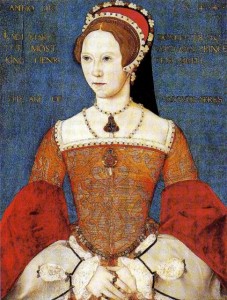 On this day in history, in the early hours of Monday 18th February 1516, at the Palace of Placentia in Greenwich, Catherine of Aragon gave birth to a healthy daughter. It was Catherine’s sixth pregnancy (some say fifth) and it must have been a relief to hear the baby cry and see her wriggle, even if she was ‘just’ a girl.
On this day in history, in the early hours of Monday 18th February 1516, at the Palace of Placentia in Greenwich, Catherine of Aragon gave birth to a healthy daughter. It was Catherine’s sixth pregnancy (some say fifth) and it must have been a relief to hear the baby cry and see her wriggle, even if she was ‘just’ a girl.
Anna Whitelock describes how, three days after her birth, this baby girl was baptised at the nearby Church of the Observant Friars with Margaret Pole, the Countess of Salisbury, standing as her godmother. At the end of the ceremony, heralds proclaimed:-
“God send and give long life unto the right high, right noble and excellent Princess mary, Princess of England and daughter of our most dread sovereign lord the King’s Higness.”
The little girl had been named Mary after her father’s favourite sister, Mary Tudor, and Linda Porter writes of how the baby princess was “small but pretty” and “already showed signs that she had inherited the red-gold hair of both her parents and the clear Tudor complexion.” She had also inherited her parents’ pride, intelligence and strength of character. As her parents gazed at their daughter, breathing sighs of relief that she seemed fit and healthy, they would have had no idea that this tiny girl would one day be Queen of England, that she would face many challenges with courage and would fight for her throne and win. Whatever we think of Mary, the “Bloody Mary” of myth and legend or the damaged daughter of a tyrant, she should be admired for her achievements. In an excellent article on Mary, in BBC History magazine, historian David Loades listed some of Mary’s achievements:-
- She preserved the Tudor succession
- She strengthened the position of Parliament by using it for her religious settlement
- Mary established the “gender free” authority of the English crown
- She restored and strengthened the administrative structure of the Church
- Mary maintained the navy and reformed the militia
Loades concluded that “Parliament, the revenues, the navy, even the church benefited from her policies. But the big beneficiary was also the least grateful – Elizabeth. Without her sister’s enlightened legislation and sound administration she would have had a much harder time.”
I have to agree with Loades, we can admire Elizabeth and think of her reign as a Golden Age, but would Elizabeth have been as successful if her sister had not paved the way for her? It’s hard to say. I would also add another achievement to that list and that is Mary taking the throne back from Lady Jane Grey; after all, Mary was outnumbered and Jane was in the stronger position being on the throne already. It took guts to fight for the throne in the way that Mary did and it took a good politician and leader to rally support like that.
Anyway, you can read more about Mary I in the following articles:-
- The Myth of Bloody Mary
- Mary I Facts
- Elizabeth and Mary Part 1
- Elizabeth and Mary Part 2
- Elizabeth and Mary Part 3
- The Coronation of Mary I
- Anne Boleyn and Bloody Mary
Sources
- Mary Tudor: Princess, Bastard, Queen, Anna Whitelock, p3-4
- “Mary Tudor: The First Queen”, Linda Porter, p6-7
- “How Bloody Was Mary?” – An article by David Loades in BBC History Magazine, March 2006.